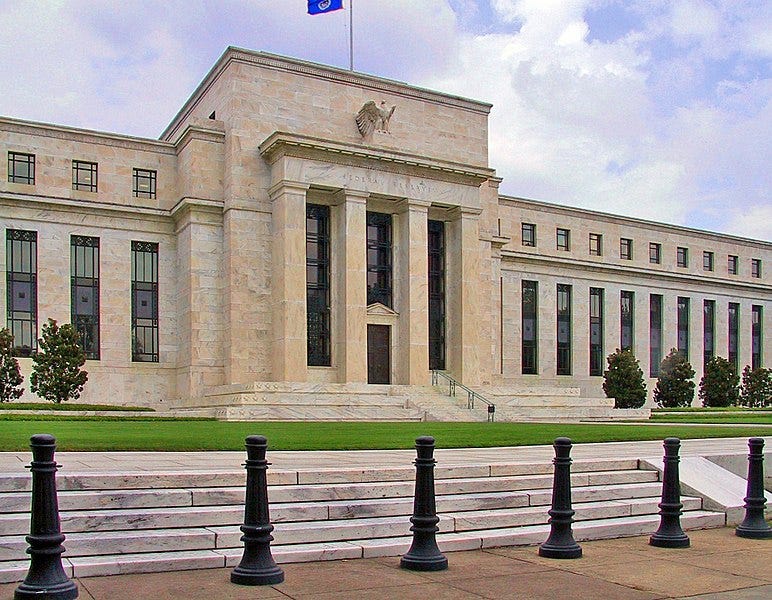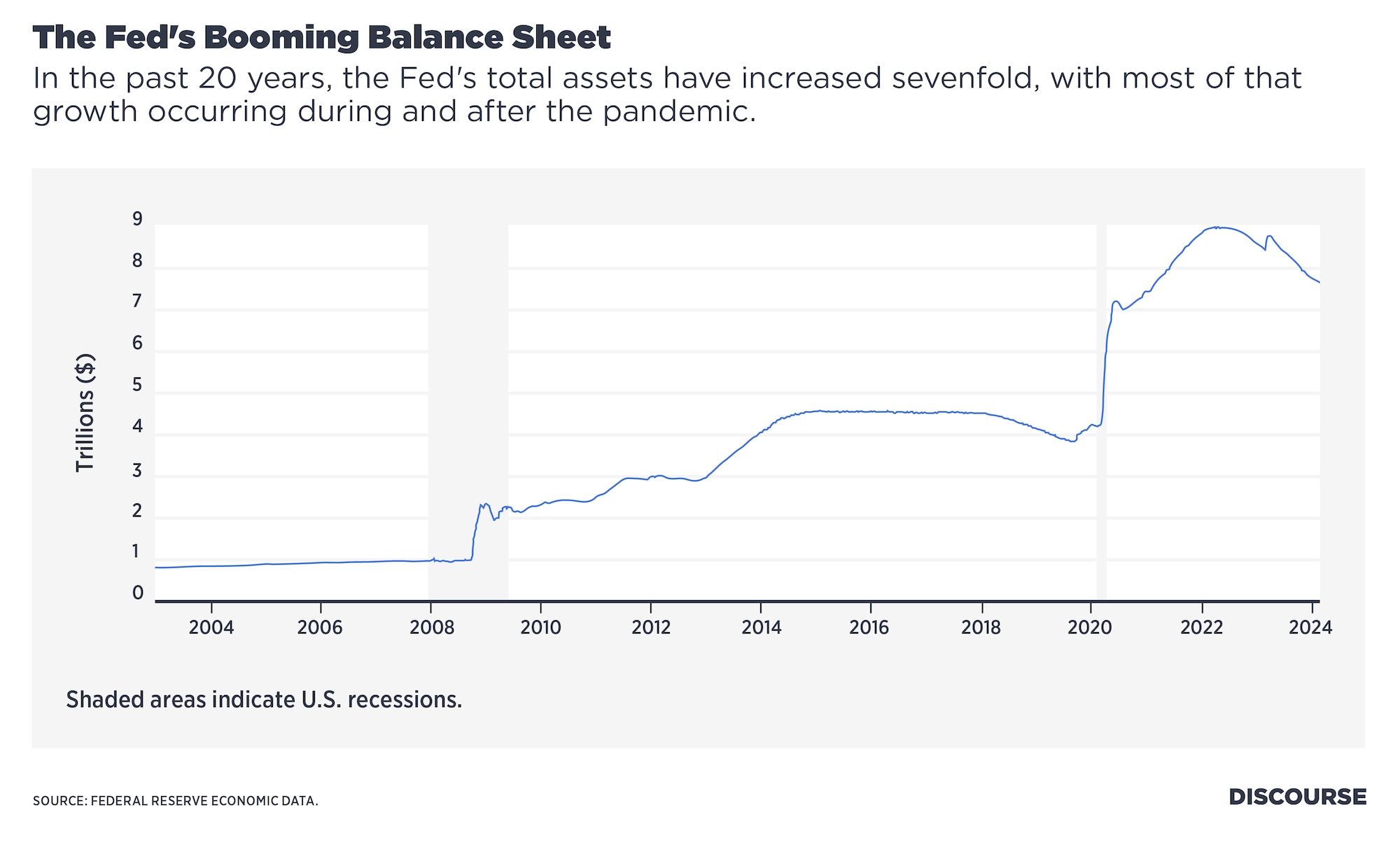|
 |
The Fed Should Keep Shrinking Its Balance Sheet
A large balance sheet entangles the Fed in political issues well beyond its monetary policy purview
Recent discussions of U.S. monetary policy have largely been dominated by two themes: inflation and the federal funds rate, the Federal Reserve’s primary tool for achieving its monetary policy goals. The federal funds rate is the overnight interest rate at which banks and other financial institutions lend reserves—cash in bank accounts held at the Fed—to each other. Observers have good reason to care about the federal funds rate: It influences practically all other interest rates—everything from savings accounts to Treasury bonds to auto and mortgage loans. With inflation close to but not quite at the Fed’s 2% target, much digital and physical ink has been spilt on if and when the Fed will start to cut the federal funds rate.
However, monetary policy is not solely about manipulating the federal funds rate. Another monetary policy tool is the Fed’s balance sheet, its financial statement showing the assets it owns and the liabilities it owes. This balance sheet grew massively during the COVID-19 pandemic and is now shrinking. At its peak in spring 2022, the balance sheet was nearly $9 trillion. Since then, it has shrunk to around $7.6 trillion. However, some economists and other observers believe that the Fed will contract the balance sheet to around $6.75 trillion this year and try to maintain it at that size.
Hopefully, the Fed will not stop there. A large balance blurs the distinction between monetary policy (the Fed’s responsibility) and fiscal policy (Congress’ responsibility) and makes the Fed vulnerable to politicization.
2008 and the Origins of the Fed’s Big Balance
Like any organization, the Fed has a balance sheet with assets on one side and liabilities on the other. Before the Great Recession, the Fed’s balance sheet was much smaller than it is today and typically fluctuated between $800 billion and $900 billion. Most of its assets were short-term Treasury bonds (“T-bills”), and its liabilities consisted of currency in circulation and bank reserves.
Back then, banks would borrow from one another in the federal funds market to make sure they had sufficient levels of reserves to cover what they were required to hold by law. Although the federal funds rate was technically determined by banks, the Fed would conduct monetary policy by manipulating it. The Fed would do this through “open-market operations” in which it would buy and sell T-bills. For example, if the Fed wanted to pursue a more expansionary monetary policy, it would buy T-bills from banks and credit those banks’ accounts at the Fed with reserves. These purchases would add liquidity to the banking system and drive down the federal funds rate because banks would have more reserves to lend to one another.
With more money in the form of reserves, banks could take those reserves and lend them to borrowers. Such lending would stimulate economic activity. Too many purchases, however, would lead to inflation higher than the Fed’s 2% inflation target, so the Fed had a strong incentive not to overdo open-market operations. If the Fed wanted to pursue a more contractionary monetary policy, this process would work in reverse, and the Fed would sell its Treasury bonds.
This approach to monetary policy came to an end in November 2008 as the Great Recession intensified. By that time, the Fed had loaned billions of dollars to financial institutions and reduced the federal funds rate to near 0%, but the economy was still in free fall. The Fed could no longer simply buy short-term Treasury bonds to stimulate the economy, so it initiated its first quantitative easing (QE) program. QE means the central bank buys longer-term assets with the goal of reducing the bond yields on those assets and adding more liquidity to the economy with the hope that economic growth will pick up.
The Fed also made another change that month, which has permanently ensured a large balance sheet. It began to pay banks interest on reserves (IOR) at a rate above other short-term interest rates. Before this change, banks had little incentive to keep extra money in the form of reserves because they would miss out on the opportunity to make interest-earning loans. However, with the Fed paying IOR, banks were happy to hold onto excess reserves.
Thus, the Fed transitioned away from what economists call a “scarce reserve” system to an “abundant reserve” system. The Fed believed transitioning to an abundant reserve system would give it greater control over monetary policy. First, the Fed could just adjust the IOR rate to move the federal funds rate up or down. Second, if it was worried about inflation, the Fed could create more reserves to provide liquidity to the banking system without necessarily stimulating the broader economy, as banks would simply keep reserves at the Fed. This change has also come with serious downsides, however, and these costs outweigh the benefits.
Bigger and Bigger
From November 2008 to October 2014, the Fed embarked on three QE programs (labeled “QE1,” “QE2” and “QE3”). QE1 was launched when the U.S. financial system seemed on the verge of collapse. QE2 and QE3 were later launched to buoy the American economy, which was still weak in the aftermath of the Great Recession. Over this time, the Fed purchased trillions of dollars in long-term Treasury bonds, mortgage-backed securities and the debt of the government-sponsored housing agencies Fannie Mae and Freddie Mac. These programs caused the Fed’s balance sheet to swell to nearly $4.5 trillion by late 2014.
After a few years of relative macroeconomic stability, the Fed engaged in the opposite of QE: quantitative tightening or QT, where it modestly shrunk its balance sheet between October 2017 and September 2019. Rather than directly sell off assets on the balance sheet, the Fed allowed assets to mature and then “roll off” the balance sheet. However, trouble started to brew as QT removed liquidity from financial markets, and the Fed aborted the program with its balance sheet standing at about $3.8 trillion.
The next major change to the Fed’s balance sheet took place as the Fed responded to the 2020 COVID-19 pandemic crisis. As it did during the Great Recession, the Fed reduced the federal funds rate to zero and made all sorts of emergency loans (this time even to nonfinancial institutions). The Fed also launched “QE4” and bought even more quantities of long-term U.S. Treasury bonds and mortgage-backed securities than it had during the previous QE programs. Even though the U.S. economy largely reopened by 2021, the Fed continued QE4 until March 2022. Later, in June 2022, the Fed began a new round of quantitative tightening. This second round of QT has been brisker than the first, but as the figure below shows, the balance sheet is still gargantuan.
Why Worry About a Big Balance Sheet?
While expanding the Fed’s balance sheet in a time of crisis (such as the Great Recession or the COVID-19 pandemic) is certainly justifiable, a large balance sheet causes the Fed to wade into fiscal policy. This is dangerous both for the Fed and for taxpayers.
To understand why, we must understand how a large balance sheet has larger fiscal implications than a small balance sheet. When the Fed buys assets like Treasury bonds, it earns interest on those assets. It uses that interest to cover its expenses and then transfers most of its profits to the U.S. Treasury. When the Fed had a scarce reserve system, it earned some profits, but these profits were relatively small because the Fed’s balance sheet was relatively small. Moreover, the Fed primarily traded T-bills, which mature quickly and have little risk of default, so revenue from this approach was very predictable.
However, things get more complicated under an abundant reserve system in which the Fed maintains a large balance sheet. The Fed can earn more interest by buying more assets, but it also pays more IOR to banks. This approach can lead to great profits or losses for the Fed.
QE1, QE2 and QE3 were all profitable for the Fed because all three QE efforts occurred in low-inflation periods when the interest on the Fed’s assets (Treasury bonds, mortgage-backed securities) was greater than the interest on its liabilities (bank reserves). By law, the Fed must send most of its profits to Congress. While observers might think large Fed profits are desirable because they provide more revenue for Congress, the allure of large profits can tempt Congress to pressure the Fed to use the balance sheet for political objectives.
This concern is not just speculative. Through the Dodd-Frank Act, the Fed already funds the Consumer Financial Protection Bureau (CFPB). While one can argue the CFPB provides an important function by protecting consumers from predatory financial practices, its purpose goes beyond the Fed’s mission of providing appropriate monetary policy. In 2015, Congress took billions of dollars from the Fed to fund an infrastructure bill. Former Philadelphia Fed president Charles Plosser has warned that these forays into funding activities unrelated to monetary policy could portend future trends where Congress instructs the Fed to fund more politically controversial projects such as a Green New Deal or bail out financially troubled state and local governments. With such intense polarization in politics today, it is not hard to see politicians of both major parties trying to use the Fed’s balance sheet as a political football.
While the first QE programs were profitable, QE4 has not been. Beginning in 2022, the Fed repeatedly and steeply raised the IOR rate to rein in inflation. With a much higher IOR, the Fed’s expenses have massively grown, while it has earned comparatively little interest on the assets it accumulated when interest rates were very low in 2020 and 2021. Moreover, since interest rates and bond prices move in opposite directions, the IOR hikes have caused the value of the Fed’s portfolio to plummet. These actions have led to massive losses, which the Fed cannot cover without resorting to accounting tricks. Ultimately, these losses come at the expense of taxpayers. Economists Andrew Levin and William Nelson estimate that QE4 could cost taxpayers as much as $1 trillion over 10 years. Such staggering losses could lead some to question why the Fed should be trusted with independence.
Fed officials like having a large balance sheet because it allows the Fed to flood the financial system with liquidity. However, a large balance sheet risks putting the Fed in political hot water. Before the Great Recession, the Fed did a reasonable job of keeping both inflation and unemployment low. This experience shows that the Fed can conduct monetary policy effectively with a small balance sheet. Fed independence is not something to be taken for granted. For that reason, the Fed should aim to keep reducing its balance sheet as much as possible.
You’re currently a free subscriber to Discourse .

